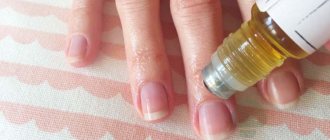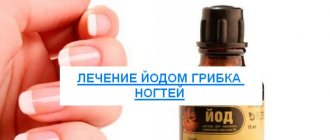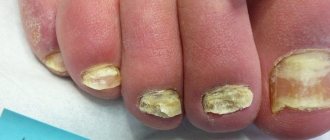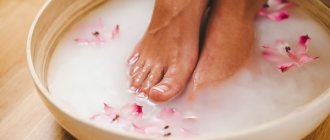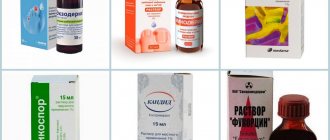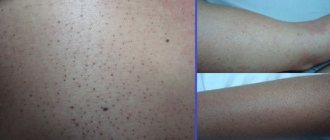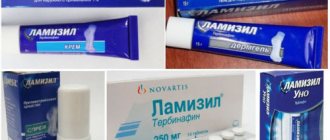Pharmaceutical preparations of various forms are used to treat fungal infections. These can be ointments, creams, sprays, gels, suppositories and tablets. If treatment is started in a timely manner, when the infection affects a small area of skin or 2-3 nails, topical agents are sufficient.
However, if the disease has spread to large areas of the body, almost all nails are affected by the fungus, or the infection has invaded the internal organs (larynx, gastrointestinal tract), medications for external use only will not give the desired effect. In this case, anti-fungal tablets are prescribed; they have a stronger effect, but can only be used as prescribed by a doctor.
In what cases are tablets prescribed?
Fungal diseases, with the exception of the initial stage, require complex treatment, that is, a combination of external and internal agents. Tablets for mycotic infections of the skin and nails are selected for the patient individually, depending on the type of pathogen identified, the area of the pathological process, the characteristics of the person’s health and the state of his immunity. It is almost impossible to take into account all these factors without the participation of a doctor.
The list of indications for prescribing antifungal drugs includes infections of the skin and nails, which are characterized by severe pathology with concomitant damage to internal organs. The tablets, entering the patient’s gastric tract, are actively absorbed by his tissues, enter the systemic bloodstream and are carried to the locations of mycosis pathogens. Concentrating in the foci of fungal infection, the active components of the drugs block the synthesis of protein fractions necessary for the growth and development of pathogenic microorganisms, resulting in their death.
To achieve a lasting therapeutic effect, it is important to use antimycotics taken orally according to the frequency and dosage specified in the specialist’s prescriptions. Skipping medications reduces the effectiveness of treatment, as the concentration of active ingredients in the mycosis site decreases. If this happens, you must take the forgotten pill as quickly as possible, but under no circumstances double its dosage. Gross violations in compliance with the treatment regimen often lead to the development of microflora resistance to medications and relapse of the pathological process.
Preventive measures
After the symptoms of the fungus disappear, you need to follow measures to prevent the return of the disease and make them a rule.
These include:
- careful treatment of nail tools;
- wearing comfortable shoes and socks made from natural fabrics;
- hygiene procedures after walking in open shoes;
- daily change of linen.
You should also not use someone else’s shoes and towels, walk barefoot in public places, or leave your feet wet.
Classification of antifungal drugs
Depending on the active components, all antimycotics are divided into the following three categories listed in the table.
| Drug groups | Description |
| POLYENES | Nystatin, Levorin, Natamycin, Amphotericin, Pimafucin. Natural antimycotics with a wide spectrum of action. They have a fungicidal and fungistatic effect, successfully destroying pathogenic microflora at the site of the disease not only on the surface of the skin and nails, but also on the mucous membranes. |
| AZOLES | Ketoconazole, Fluconazole, Itraconazole, Orungal. Synthetic drugs. They have a wide spectrum of action against all known pathogens of fungal infections. |
| ALLYLAMINES | Terbinafine, Naftifine, Lamisil. Synthetic agents effective against dermatomycosis when the pathological process is localized on the skin, nails and hair. |
| DRUGS OF DIFFERENT GROUPS | Griseowulfine, Potassium Iodide. The very first antimycotics of natural origin, which have a narrow spectrum of action. Prescribed for fungal infections caused by dermatophytes. |
Indications for use
Antimycotic drugs are prescribed for fungal infections of the nail plates (onychomycosis), skin of the feet and hands.
There are several types of onychomycosis:
- normotrophic;
- atrophic;
- hypertrophic.
With the normotrophic manifestation of onychomycosis, the color of the nail changes, white or yellowish stripes and spots appear, which over time can cover the entire surface. But their appearance does not affect the thickness and shine of the nail plate.
The atrophic form causes a change in color - the nail may acquire a gray tint and become dull. The destruction of the plate begins until complete atrophy. With hypertrophic fungal infection, not only the color of the nail changes, but also its thickness. The nail plates become dull, crumble, become deformed, and the usual shine disappears.
To achieve positive results and completely destroy the fungus, doctors prescribe complex therapy - not only drugs in tablets, but also external agents that act locally.
Review of effective drugs
Itraconazole A broad-spectrum medication that has a universal effect on known types of mycosis pathogens, including its rare forms. The remedy is prescribed for all types of fungal flora: dermatophytes, yeast and mold microorganisms.
The drug is not recommended for persons with chronic pathologies of the liver and kidneys. It is prescribed according to the so-called pulse therapy scheme:
- 7 days take 200 mg 2 times a day;
- 3 weeks break.
In general, 3 such courses are needed to help get rid of the advanced form of onychomycosis. If we are talking about treating skin fungus, then taking 2 courses of Itraconazole is quite enough.
Lamisil. The drug inhibits the fermentation of fungal flora, as a result of which their metabolism is disrupted and microorganisms inevitably die. The active substance of the drug is effective against dermatophytes.
Lamisil tablets are taken daily for 2 months. Only during this period will the drug help cope with the infection, especially when it comes to onychomycosis of the hands and feet. Since a long-term treatment regimen is provided, systemic side effects may develop, for example, loss of appetite, gastrointestinal disorders.
Fluconazole (Diflucan). The drug is available in capsules. Most often it is prescribed for thrush in women, but it is also effective against nail fungus. Fluconazole is considered a gentle drug, since it is enough to take one capsule per week to treat mycotic infections. This excludes a pronounced systemic effect on the body.
The active components of Fluconazole are detected in plasma 1 hour after taking the capsule. If we are talking about the treatment of onychomycosis, then the concentration of the drug reaches 90% in the stratum corneum of the nail after 5 days from the start of therapy. From this day on, Fluconazole begins to actively destroy the cells of infectious agents.
Its effectiveness has been proven against all types of fungi - dermatophytes, yeasts and molds. The duration of treatment depends on the stage of the pathological process and the state of the person’s immune system. On average, it takes from 6 to 12 months to fight onychomycosis. The drug should be continued until healthy nail plates grow back. In advanced cases, Fluconazole is prescribed daily, one capsule (50 mg) for 2–6 weeks.
Experts consider this medication to be a high-level safety product. There is no evidence of its negative effect on the functioning of the liver and kidneys, as well as the hematopoietic organs. But in any case, it is undesirable for people with such disorders to take Fluconazole, in the presence of individual intolerance to the drug, during pregnancy and breastfeeding.
Nystatin. A cheap product from the polyene group. Shows effectiveness against Candida type fungi localized on the mucous membranes of the oropharynx and gastrointestinal tract, skin and nails.
For onychomycosis, Nystatin is prescribed 1 tablet (200 mg) once a day. Treatment is continued until healthy nail tissue grows back. On average, the duration of therapy ranges from 6 to 12 months.
The drug has the only contraindication - hypersensitivity to its individual components. Adverse reactions develop extremely rarely, since Nystatin derivatives are practically not absorbed into the systemic circulation. These include: gastrointestinal disorders, hyperthermia and allergies.
Currently, the drug has been discontinued; it is recommended to replace it with analogues, for example, oral tablets Lamisil, Ketoconazole.
Terbinafine. A systemic antifungal agent that is effective against dermatophytes and yeast-like microorganisms. To combat onychomycosis, the drug is prescribed 1 tablet once a day. The duration of therapy depends on the severity of the pathological process and the type of pathogen.
Terbinafine is not recommended for use by persons with individual hypersensitivity to its components.
Irunin. An effective drug for systemic infections, which can be used to treat not only nail fungus, but also skin and mucous membranes affected by mycosis. The medication is prescribed according to the regimen - 1 capsule per day for 15 days.
Irunin is not used during pregnancy and breastfeeding. However, the medicine is not contraindicated for people with diabetes.
Exiter. Fungicidal drug based on terbinafine. The product dissolves the membrane of mycosis pathogens, causing their death. Shows activity against all types of fungi.
The drug is prescribed 1 tablet per day. The duration of therapy depends on the severity of the pathological process. Treatment of onychomycosis involves taking Exitera daily for several months until the symptoms of the disease disappear.
The drug has restrictions for use in expectant and nursing mothers, as well as in the elderly.
Orungal. A systemic antimycotic, which is recommended for use in complicated cases of fungal disease, mycotic infections of the skin and nails, and vaginal candidiasis in women.
The drug is prescribed according to the following regimen: 1 tablet 2 times a day for 7 days.
Orungal is contraindicated during pregnancy and lactation, heart and vascular diseases, hypersensitivity to the medication. While taking it, tissue swelling and disorders in the functioning of the digestive system may develop.
Lamicon. The drug is based on terbinafine, a substance active in the fight against fungal diseases of the skin, nails and scalp. The tablets are taken once a day until the symptoms of onychomycosis disappear.
It is not recommended to take Lamikon during pregnancy and lactation, or if you are allergic to the drug.
Exifin. A drug based on terbinafine, which has a wide spectrum of action. Tablets are prescribed once a day for 2–12 weeks, depending on the severity of the pathological process.
Adverse reactions to Exifin include headaches and nausea, which can be eliminated by taking sorbents, for example, Activated Carbon. The drug is contraindicated during pregnancy and breastfeeding.
Pimafucin. Affordable and effective tablets that have a wide spectrum of action. It is recommended to use them in combination with local remedies, for example, Pimafucin cream of the same name. The drug should be taken 1 tablet 4 times a day for 2–3 months.
The medicine is contraindicated in case of an allergic reaction to its components. Pimafucin is prescribed with caution to expectant and nursing mothers and people with diabetes. Among the side effects of the medication are gastrointestinal disorders that go away on their own, without symptomatic treatment.
Griseofulvin. The pharmacological effect of this drug differs from other oral antimycotics. In addition to the death of fungal microflora by destroying DNA synthesis, the product causes the death of the affected areas, which are subsequently replaced by healthy tissues. Thus, Griseofulvin heals the nail and makes it resistant to the possible introduction of fungus in the future.
The drug is prescribed orally at a dosage of 500,000 units per day. If we are talking about an advanced form of onychomycosis, the volume of medication is doubled. The disease is fought for at least 6–12 months. Recently, Griseofulvin has been prescribed less and less due to its pronounced toxic effect on the body.
Thermikon. In the fight against nail and skin fungus, the drug is prescribed in tablet form. The drug is taken according to the regimen - 250 mg or one pill per day. The course of treatment depends on the neglect of a particular case until the signs of onychomycosis disappear. On average, this takes about 3 months.
Additionally, it is recommended to use antifungal ointments and sprays that enhance the effect of Thermikon externally.
Furacilin. A drug known for its antiseptic and disinfectant properties. For onychomycosis, it is used in the form of an aqueous solution, that is, the oral route of taking the medication is excluded.
To prepare the remedy, 2 tablets of Furacilin are dissolved in 200 ml of purified water, heated to a temperature of 40°C. The resulting composition is used for baths, where the affected parts of the body - hands or feet - are immersed. The product reduces the manifestations of inflammation in the focus of onychomycosis, destroys pathogenic microflora, and accelerates recovery.
A negative reaction to this procedure is an allergy, which goes away after discontinuation of the drug. Local use of Furacilin is contraindicated in case of hypersensitivity to its active components.
The following two products are included in this list because many people believe that they come in tablet form - this is not the case. However, their use is no less effective with an integrated approach.
Exoderil. For nail fungus on the toes and hands, there are no tablets with this name. To combat onychomycosis, a solution is used that is most convenient for treating the foot.
Exoderil is based on naftifine hydrochloride, which has the ability to penetrate into the deep layers of the skin and nail fold, creating a pronounced fungicidal effect. Additionally, the medication provides an anti-inflammatory and symptomatic effect in the affected area, relieving the patient of itching, burning and redness.
Exoderil in the form of a cream is applied to nails, previously steamed in a bath and cleaned of excess stratum corneum. The recommended course of treatment is 6–8 months. Elderly people have to use the medication for up to one and a half years. However, it is not advisable to stop there - after the signs of onychomycosis disappear, the use of Exoderil should be continued for another 4 weeks to avoid relapse of the infection.
Clotrimazole. The list of tablets intended for nail fungus cannot be called modest, but this drug is not included in this list. Clotrimazole is available in the form of ointments that effectively cope with mycoses of the skin and nails.
The drug is applied to the foci of onychomycosis 2 times a day until the affected tissues are completely replaced with healthy ones. The effectiveness of the product is due to imidazole, a substance that inhibits the production of ergosterol, which provokes the inevitable death of the fungus.
Recommendations
Tablets for the treatment of nail fungus will help cope with the infection if the patient listens to the doctor’s recommendations during the course of taking them.
Experts advise to quickly destroy onychomycosis:
- strictly follow the drug dosage regimen, since the effect of the medication is designed for a cumulative effect;
- take care of the nail plates by regularly carrying out the necessary procedures for treating the affected area;
- additionally use antifungal creams or ointments and traditional medicine (compresses, baths, etc.);
- follow a diet excluding foods that provoke fungal growth;
- observe all rules of personal hygiene to prevent relapse and infection of other people.
It is not difficult to cope with a fungus that affects your fingernails or toenails. Treatment with tablets takes an average of two weeks. But if you start the disease, you can get a chronic form. In this case, the infection will occur periodically and it will be very difficult to completely eliminate it.
Tablets for skin fungus
In recent years, the number of people with dermatomycosis has been increasing. The development of infection is facilitated by unfavorable environmental conditions, lifestyle and much more. If you experience symptoms such as itching, spots and swelling on the skin, you should immediately consult a dermatologist.
The specialist will conduct a standard examination, prescribe a series of tests, with the help of which the causative agent of the disease will be identified and medications in the form of ointments, sprays and tablets will be selected for it. How do systemic oral antifungals work in this case?
The purpose of any antimycotic is to prevent the growth and development of pathogenic microorganisms and create conditions for their death. This mechanism of action is carried out by blocking enzymes in the cellular structures of mycospores. Let's look at the main medications for skin fungus.
- Griseofulvin. Effective against mycosis of the skin, nails and scalp (dandruff, seborrhea). For dermatomycosis, the drug is taken according to the formula: 1 tablet per 10 kg of weight. The duration of therapy depends on the diagnosis and health status of the patient.
- Ketoconazole. An antifungal drug used in the fight against mycoses of the skin, internal organs, mucous membranes, nails and hair. For dermatomycosis, 1 tablet per day is prescribed. The course of treatment depends on the diagnosis and the severity of the pathological process.
- Fluconazole (Diflucan). Fights fungal infections of the skin and mucous membranes of the genital organs, including among patients with HIV and AIDS, during radiation therapy for cancer conditions. Recommended regimen: 1 tablet per day in a dosage of 50 to 400 mg, depending on the severity of the pathology.
- Nystatin. An antifungal agent aimed at eliminating diseases caused by the Candida pathogen. The drug is prescribed at a dose of 500,000 units 3 times a day. The duration of therapy depends on the diagnosis.
- Terbinafine (Lamisil, Lamican). The antimycotic successfully fights mycoses of the skin, nails and hair. Effective against all known pathogens of fungal infections. For dermatomycosis, 1 tablet is prescribed 1-2 times a day, depending on the severity of the pathological process.
Features of their treatment
Before prescribing such treatment, the dermatologist takes scales from the affected area for laboratory testing to identify the type of pathogen. As soon as the parasitic fungus is identified, the doctor will draw up a complex treatment regimen, which must be strictly followed, otherwise the treatment will be ineffective.
The pulse method of treatment is considered the most effective.
It is based on the use of various medications, which are taken with increasing doses in short courses and breaks for a long time.
But before prescribing pulse therapy, the doctor conducts a comprehensive study.
Initial treatment with a tablet drug has a slow effect and has a number of side effects. Before making a prescription, a dermatologist must provide for the following conditions :
- Allergies – Oral antifungals are highly toxic and may cause a reaction in the body, especially if the patient is allergic to certain foods.
- Pregnancy – treating fungus with tablets during pregnancy is strictly prohibited.
- Lactation period - no treatment.
- Concomitant diseases - antifungal drugs can interact with other medications, and their use may be ineffective and even dangerous in some cases.
- Abuse of alcoholic beverages – taking anti-bending tablets together with alcohol can lead to undesirable consequences.
- Age of the patient – when prescribing drugs, the general condition of the patient’s body is taken into account.
You cannot increase the dose of the drug on your own. When treating a fungal disease, a complex of vitamins is additionally prescribed that will help improve the body's immunity and resistance to infection.
Price of drugs
Fungal diseases are quite common, and their treatment varies in duration. The minimum course of systemic therapy for mycosis of nails and skin is from 6 weeks to 6 months. It cannot be interrupted to avoid the development of resistance in pathogens and relapse of the pathology. Therefore, it is important to know in advance how much treatment will cost, since not all antimycotics are cheap.
Let’s conduct a comparative analysis of their price category in the table and find out which tablets for existing nail fungus can be called inexpensive but effective.
| Drugs | Approximate cost (Russia, Ukraine) |
| LAMISIL | 14 tab. 2100 rub. / 946 gr. |
| ORUNGAL | 14 drops 2000 rub. / 938 gr. |
| EXITER | 14 tab. 1600 rub. / 679 gr. |
| EXIFIN | 16 tab. 856 rub. / 734 gr. |
| TERMIKON | 14 tab. 515 rub. / 355 gr. 28 tab. 855 rub. / 615 gr. |
| IRUNIN | 6 tab. 437 rub. / 335 gr. 10 tab. 638 rub. / 495 gr. 14 tab. 778 rub. / 658 gr. |
| PIMAFUTSIN | 20 tab. 517 rub. / 138 gr. |
| TERBINAFINE | 10 tab. 181 rub. / 39 gr. 14 tab. 515 rub. / 71 gr. 28 tab. 850 rub. / 125 gr. |
| GRISEOULVIN | 20 tab. 269 rub. / 36 gr. |
| KETOCONAZOLE | 10 tab. 162 rub. / 25 gr. |
According to the table, Lamisil and Orungal are considered the most expensive drugs aimed at combating fungal infections of the skin and nails. Griseovulfine and Ketoconazole will help you save your budget.
But the cost of drugs cannot be compared with their effectiveness. It is enough to note that Lamisil destroys pathogenic microflora in 97% of clinical cases, while Griseovulfine is not recommended for use due to increased toxicity, and Ketoconazole has a narrow spectrum of action. Therefore, savings should be reasonable, taking into account the existing diagnosis and prescriptions of the attending physician.
Is it possible to fight onychomycosis without pills?
In most cases this is not feasible. The fact is that visible signs of nail damage appear at advanced stages of the disease; in this case, the lack of a systematic approach will lead to long-term local treatment with minimal external improvements to the problem.
Therefore, if the disease no longer corresponds to the initial stage, the affected area is extensive and the pathological process develops quickly - it is necessary to use systemic antimycotics to successfully get rid of the disease.
Prevention measures
Prevention of the disease is extremely important, since mycosis is an easily transmitted disease. It becomes even more important if you have recently gotten rid of the disease. This is due to the fact that it is fraught with relapses. To effectively carry out prevention, it is necessary to know how pathogens penetrate inside. This happens when they come into contact with the skin and nail plates.
The most likely source of infection is public places. These could be swimming pools, baths, saunas. Microorganisms multiply easily in damp and warm places. To become infected, it is enough to walk barefoot on the floor. To avoid this, you need to carry slippers with you everywhere.
The disease is transmitted through microdamages on the skin. They are typical if the feet are not well-groomed: they have calluses, the skin is dry. Therefore, to eliminate the disease, you need to do a high-quality pedicure and lubricate your feet with moisturizer.
The best prevention of illness is good immunity. It may well save you from the proliferation of pathogenic microorganisms. You can strengthen it with physical activity and a proper diet.
Pros and cons of tablets
Like any medications, medications for nail and skin fungus have their positive and negative sides. What are they?
Strengths. When taking antimycotics orally, the drug enters the digestive tract, is absorbed into the systemic bloodstream and begins its action from the inside. Therefore, in this case, it works purposefully and effectively against a wide range of pathogens, in contrast to local drugs.
All types of fungal infections fall under the influence of the tablets - both those that have managed to manifest themselves externally on the surface of the skin and nails, and those that “dormant” in the body and make themselves felt by relapses of the pathological process against the background of weakened immunity. External medications cannot do this.
Minuses. But in addition to the undeniable advantages, tablets have one significant drawback. When taking them internally, the result should be expected a little later. The pharmacological effect does not occur so quickly, since oral medications need time to accumulate in the required concentration at the site of the lesion, only after which they begin to work. In comparison, local ointments and gels begin to show their activity almost instantly.
Orungamin
Orungamine (some mistakenly call it orutamine) is one of the effective drugs that has antifungal effects on the feet. The active ingredient is itraconazole. Such tablets are mainly prescribed for extensive types of fungus .
How to use?
Take the drug 2 capsules twice a day . The active substance is activated after 4 hours. The medicine is concentrated as much as possible in the areas affected by mycosis. The duration of the course and the break between them can only be prescribed by a doctor. For hands and nails, treatment lasts 5 weeks, for toenail fungus – 9, including breaks.
Side effects and contraindications
Oral medications for mycotic infections are not prescribed in the following cases:
- pregnancy and breastfeeding;
- kidney and liver diseases;
- children under 5 years of age;
- individual hypersensitivity to individual components of the selected drug.
Antifungal tablets are recommended to be taken with caution by people with immune problems, the elderly and those suffering from diabetes.
All systemic drugs cause negative reactions. They have a certain effect on the body, which can lead to the development of side effects, in particular, disturbances in the functioning of the liver and kidneys, allergic reactions, including anaphylactic shock. The most harmless side effects are headaches, nausea and diarrhea.
Griseofulvin
The active substance of the drug is griseofulvin (125 mg). It suppresses fungal cell division and prevents them from developing. The package contains 20 tablets. The duration of the course can be up to 8 months. In the 1st month, the tablets are taken daily, in the 2nd month - every other day, from the 3rd month the drug is taken twice a week.
The recommended dose for adults is 500 mg per day. For children (over 2 years old), the dosage is calculated individually. It is better to take tablets after meals or during meals - along with foods rich in fat. Side effects are the same as most of the previously listed antifungal agents.
Contraindications:
- renal failure;
- individual intolerance;
- liver pathologies;
- lupus erythematosus;
- pregnancy, lactation;
- oncological diseases;
- uterine bleeding;
- diseases of the circulatory system.
Are all products suitable for children, pregnant and lactating women?
Pregnancy and breastfeeding exclude the use of systemic antifungal drugs. The active components of these drugs penetrate the placental barrier into breast milk and can harm the baby. Therefore, during such a crucial period for a woman, oral medications should be abandoned or treatment should be carried out under the strict supervision of a doctor.
Children under 5 years of age are also not recommended to take systemic medications unless prescribed by a specialist. Fortunately, onychomycosis in young patients is quite rare.

